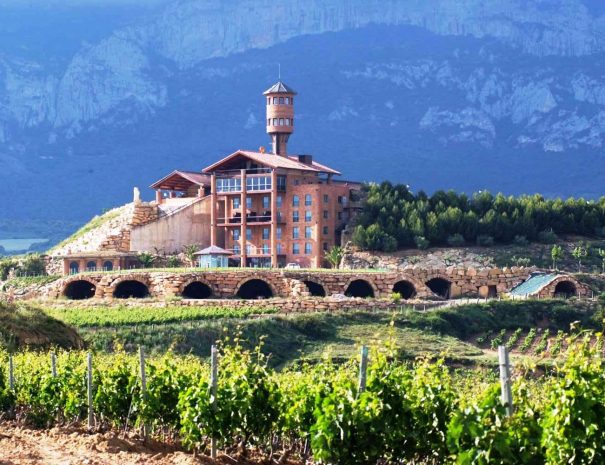
Hotels in Rioja – the top 10 hotels in Rioja
Winetourismspain´s blog with articles about Spain´s wine regions, wine tours in Spain´s wine country, local wines and gastronomy … Read More
If you are planning on visiting Rioja and you need to plan things to do while you are there, you are in the right place. This article is filled with information on cool and fun things to do when you visit this amazing region of Spain.
Apart from this article you can also check out our wine regions section where you can also find itineraries, Rioja wine maps and information on Riojan wine as well as different activities and cellars you can do/visit as well.
Rioja is a wonderful place to visit in Spain for people who love food, wine and history. To really get to know Rioja you need much more than a day, but this article will help you cram as much Rioja as possible into one amazing day, with activities, history, amazing sights, and delicious food.
Before we get into it, if you are interested in booking a tour of Rioja and let us handle the planning click bellow:

Winetourismspain´s blog with articles about Spain´s wine regions, wine tours in Spain´s wine country, local wines and gastronomy … Read More
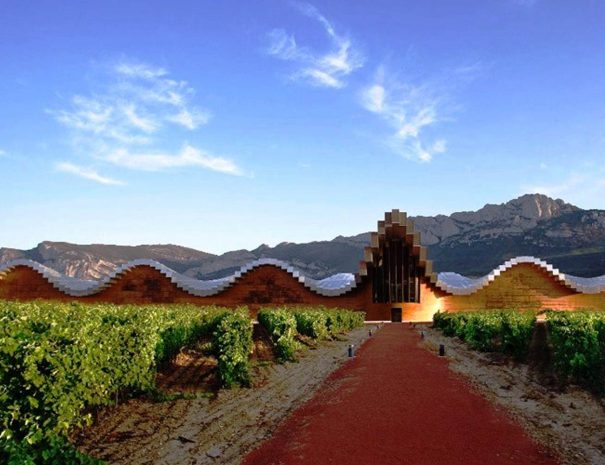
Discover the best of La Rioja with this short but complete road trip itinerary in Spain´s top wine region in which you will visit emblematic wineries and taste their wines, explore magnificent landscapes, taste the traditional gastronomy of Rioja, get to know its culture and curiosities, and enjoy activities related to the world of wine. We have carefully selected each of the services recommended to make this the best way to discover this wonderful region. … Read More
Though they might seem similar (and they are all related) they refer to completely different things. Spain is divided into Autonomous Communities, similar to how the US is divided into States. La Rioja is one of those autonomous communities and a big chunk of the Rioja wine region is located within its borders. In La Rioja, we find towns as important as Santo Domingo de la Calzada or Ezcaray, as well as the important wine cities of Haro, Calahorra, Briones or Logroño, capital of the region. Another thing to know when we talk about Rioja as a wine region is that, although most of the region is located in La Rioja, there is a portion of the wine region located in the Basque country and another smaller bit in Navarra. That’s the biggest difference between La Rioja (autonomous community) and Rioja (wine region). Not all Rioja wine is made in La Rioja.
The Rioja appellation has a series of stringent requirements for a wine to be able to be labeled as Rioja wine. If a wine made in the designated region, meets the requirements it can be labeled as Rioja wine and the generic “el rioja” refers to those wines labeled as such by the appellation.
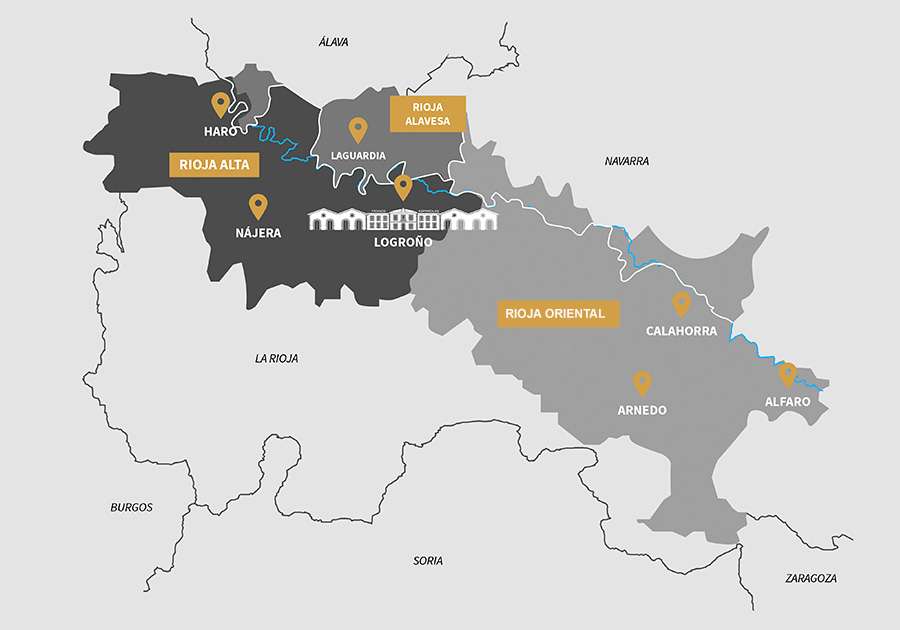
Walking through different wineries and talking with the locals, I have been sometimes asked: What do you think came to Rioja first, the vineyards or the wine? It is a good question and considering that vineyards showed up in Spain over 3000 years ago thanks to the Phoenicians, it’s safe to think that wine probably came first, even if the wine from that period is nothing like the wine we drink today. What we do know is that the Romans introduced vineyards and wine to the Rioja region as they flooded the Iberian Peninsula with vineyards.
After the Christian reconquering of Spain and the opening of monasteries across the country, the clergy became the main grape growers and winemakers in Spain and Rioja. There was a period in which wine production stopped in Rioja. People commonly attribute this to the conquering of Rioja by the Muslims. What actually happened was that Rioja was at a crossroads along the borders of the Kingdoms of Castile, Navarra, Aragon, and Al-Andalus, so the fields of Rioja were used more for war than wine.
Once the region was reconquered and there was a period of stability, Rioja became a rest area for tired pilgrims and travellers, who followed the Camino de Santiago to what is currently the Galician capital and became once again a wine-producing region (you can read more about the Camino de Santiago in our special Post of The Camino de Santiago by car)

During the 18th century, the first iteration of a governing body surrounding wine production in Rioja was created. It was called the Real Junta de Cosecheros, based in Fuenmayor, La Rioja. It was an association of the people in charge of winemaking in the surrounding area who established a series of rules to standardize the winemaking process such as: “The inhabitants of the town X will not be able to acquire wine from the town Y until the reserves of the town X have not been exhausted”. They also established rules related to the quality of the wines and after some meetings, it was decided to start exporting to the English market, via the port of Santander. A whole new business for farmers in the area.
But the biggest change came about a hundred years later when phylloxera plague decimated the vineyards in France. Spain became the largest supplier of wine to France and production skyrocketed as did the marketing and branding of Rioja wine. The wine also improved drastically as the French introduced techniques and aging processes to the Region. Another lucky coincidence was the arrival of the industrial revolution which facilitated the transportation process. A railway was created to transport grapes and wine between from Rioja to Bilbao in the town of Haro. This pushed the winemakers in the area to set up shop close to the train station to reduce costs, creating a cluster of wineries in what is known as the “barrio de la estación”. From Bilbao, the wine was shipped to England and France.
Thanks to its privileged geographical location Haro became one of the richest cities in Spain and, along with Jerez, was the first city in Spain to have electricity, and Haro has housed one of the headquarters of the Spanish National Bank since 1892
We have been talking about the history of wines and why Rioja is so known worldwide, but La Rioja is also one of the best food regions in Spain. Traditional Riojan cuisine is rustic and simple, putting all its emphasis on the quality of its ingredients. Rioja is particularly well in Spain known for its produce.
Where to eat in Rioja? There are many different options to eat well on any budget in Rioja: from tapas, to Michelin star restaurants to picnics among the vineyards, no matter how you choose to enjoy your meal, there is a delicious option waiting for you.

Tapas in Rioja. This is one of the more popular options. The Herradura neighborhood, Laurel and San Juan streets in Logroño, the pintxos rout in Nájera, etc. all are well known across Spain for the excellent quality of their tapas which of course are paired to perfection with the wine.
One of the best-known tapas areas in Rioja. Located in the historic center of Haro, these three streets bring together some of the best bars and restaurants for tapas.
Beethoven Restaurant has 3 locations, 1, 2 and 3. Where you can enjoy anything from tapas to pintxos to a full 3-course meal.
Chamonix, right next to Arrope, has one of the best grills in the area. On Santo Tomás street, you can find Los Berrones, who are famous for there stuffed peppers pintxo.
On the next street over Los Caños and El Jarrero and La Jarrera. They are all more formal, “sit down” style restaurants, but the are worth mentioning.
Laurel Street in Logroño is perhaps the best-known street in La Rioja for tapas. This street of just one hundred and thirty meters is filled with restaurants, bars, pintxo joints, etc. its all food and wine everywhere you look. Some of our favorites places are Juan and Pintxame, Soriano, La Tavina, Laurel Tavern, Lorenzo Bar, Jubera or El Mesón del Abuelo. This area is also referred to as the elephant’s path, the theory being that ¡, if you had a glass of wine in each of the over 50 bars you would have to go home “trompa” (Spanish expression that means to be drunk but literally translated means elephant trunk) and on all 4.
Very close to Laurel Street is another iconic cluster of bars, San Juan Street. San Juan street is more laid back and tranquil than Laurel street. Here you can find amazing places such as Tastavin, Floren’s Cave or Torres.
But in addition to the pintxo bars, in Logroño we can find amazing restaurants to eat in a more peaceful setting. For this we recommend Wine Fandango, where in addition to finding a great variety of wines, you can enjoy a traditional meal with a modern twist. Restaurant La Cocina de Ramón has a similar style of cooking and then if you want something more traditional we recommend Cachetero or Lavid de Laurel or the Asador Herventia.
If Rioja has some of the best produce in Spain Calahorra has the best produce within Rioja. The vegetables grown in this area are absolutely superb. In fact, in Calahorra they created the Gastronomic Conference Vegetables that are usually held in the month of April. They take their produce very seriously.
In the area of Paseo de Mercadal, you will find some of the best tapas bars in town, but the truth is that many others are scattered throughout the city, as is the case of Sabor.es, Chiqui or D’Tapas.
In the area of Rioja Alavesa (the part of Rioja in the Basque Country) the main attraction is Laguardia. A Medieval walled village and a great place to enjoy tapas and pintxos. In the center of town, you will find several must-visit establishments such as Cueva de Lobos where you can enjoy tapas at the bar or a large indulgent meal in the steak house. For pintxos, we recommend Hiruko, very close to town hall, La vinoteca or for something more formal, Los Parajes, El Collado, or the Posada Mayor de Migueloa.
You can’t visit Rioja and not have at least one meal at a winery, it’s one of the attractions of Rioja. Many wineries in Rioja have amazing restaurants on site. From picnics to dining in the old “guradaviñas”, to dining in the ancient cave style cellars, there all kinds of dining experiences available. If laying out on a blanket between vineyards or eating in the countryside is not your thing, you might prefer to visit a prestigious winery for something a little more sophisticated. Muga, Bodegas Luis Alegre, Bodegas Baigorri, and Marqués de Riscal are some of the standouts for this type of dining. In fact, at Marqués de Riscal, in its beautiful hotel designed by the Canadian Frank Ghery, you can enjoy a Michelin Star menu in one of its restaurants.
We also have Gourmet and paired visits in which the visit is combined with a small pairing in the same winery and even exclusive products of Turismodevino.com in which we include several services to enjoy wonderful wine and gastronomic day in Rioja.
When visiting Rioja, you will also have to go sight-seeing and discover some of the most charming villages in the country, the amazing architecture and historical monuments. The Rioja area (La Rioja, Navarra, and the Basque Country) features some of the most beautiful villages in Spain. Every year, in Spain, a list is made with the top villages to visit and whether it be because of their landscape, architectural or artistic charm, or their historical relevance this area of Spain always a very high concentration of these villages.
To the northwest of the region, we find Briones, Cellorigo, San Vicente de la Sonsierra, Ezcaray, Haro, Santo Domingo de la Calzada, and Calahorra.
One of the mandatory stops both for pilgrims who trek the Camino de Santiago and for visitors who decide to stop on their way in the southeast area of La Rioja. It has an impressive cathedral that built with several different architectural styles. It started being Romanesque, but it has baroque elements as well. In the town, we also have one of the most impressive Paradores in the area, perfect for a drink or rest for a few hours, just as the pilgrims used to do.
Haro is often called the capital of Rioja. As we mentioned before it is here where the wine from Rioja was transported north to Bilbao. Because of this winery fought for real estate close to the station, jockeying to be as close as possible to the station. This neighborhood has since become a required destination for wine lovers. Within 5 minutes from one another, we can find López de Heredia, CVNE, Gómez Cruzado, La Rioja Alta, Roda and Muga among others. The center of town also is also worth visiting to see the relics that remain of a more opulent time in Haro.
This small town located at the north end of La Rioja is one of the most impressive municipalities in the area. Called the pulpit of Rioja, it is located at the foot of the Sierra de Cantabria and has a special charm, because of the location, the surrounding nature, and for how tiny it is. Currently, only 13 people live here.
Ezcaray is located in the Sierra de la Demanda. The small town sits at the bottom of the most famous ski slopes in Rioja. We can find an amazing architecture, reminiscent of northern Europe, in which the use of sandstone and the decorative elements stand out. In the surroundings, there are several hiking trails that take you into the mountains.
The religious capital of La Rioja stands out for its impressive Gothic-style Cathedral with details characteristic of the Renaissance. Calahorra, in addition to being considered the religious capital, is also the horticultural capital of La Rioja…
To visit we can take a tour of the historic center, see some of the monuments that remain from the Roman era or stroll along the old Camino de Santiago that passes through the town.
It is one of the most iconic villages in Rioja Alta. Its castle and church at the top of the hill, are two of the most photographed places in the Rioja Alta. The views from here are spectacular, with the vineyards spreading out at your feet. A very special spot.
From San Vicente we move on to Briones, another town in Rioja Alta. This charming little town located atop another hill (a reoccurring theme in the region) and it offers impressive views of the surrounding area, the vineyards, and the mountain. In Briones, you can also visit one of the top wineries in Rioja: Vivanco. Walking through its streets, we can see impressive stone buildings and beautiful squares.
This is more of an area than a proper village. The north westers mountainous area of La Rioja home to many charming villages but also to some of the best cheeses in the region. Centuries ago this region was a large part of the wool industry in Sapin. We can highlight the towns of Torrecilla in Cameros, Ortigosa or Soto among many other locations. It is worth visiting the area to taste its cheeses, admire its landscapes and enjoy the Sierra Cebollera Natural Park.
Another important stop on the Camino de Santiago as it passes through Rioja. This town has spectacular landscapes cut through by the Najerilla River. You can visit the Natural Park of Najera through which you can discover nature walking next to the river. But the town has many other things to visit: the Royal Parish of the Holy Cross, the Alcazar, the botanical garden…
Recently added to the Association of Prettiest Villages in Spain, these two small neighboring towns are one of the best examples of the architecture of the XVI and XVII of the area. Cobblestone streets, mountain houses, and a laid-back atmosphere. They are located at over 1000 m altitude. 100% mountain villages.
Considered one of the most beautiful villages in Spain. This small medieval town has one of the most spectacular viewpoints in Rioja. In the center of town, you will find the town hall, which has a very famous clock. The clock is, in fact, a Glockenspiel Clock with three figures that come out and dance every hour on the hour. We can also highlight the Church of Santa María de los Reyes.
As we saw at the beginning of the article, the area had many political and border changes during the Middle Ages since the Kingdoms of Castile, Navarra, Aragon and the Muslim kingdoms collided and fought in this area for control of the territory. Therefore, there were many hills that were fortified with castles to be able to control the land bellow.
The municipality belongs to the Association of “The most beautiful villages in Spain”. It is a municipality located northwest of La Rioja, very close to Haro. Built-in the 15th century, the castle is one of the most striking in the region. Currently, It is privately owned, so you can’t go in, but the views of the exterior are well worth a short visit. The town also has other monuments worth seeing like part of the old wall and one of the old entrances to the city.
Is without a doubt one of the most impressive fortifications of La Rioja. Erected on top of a rock, it is a Muslim-style fortification and conquered by Christians in the tenth century. You can currently go in and visit the Castle.
A municipality located in the southeast of the region. This municipality has a large number of monuments and places of interest to visit. In addition to the castle that you can also go in and visit, There are several churches and also in the area, there are several dinosaur fossils you can enjoy.
Very close to Cornago we find Arnedo, a municipality in the area of Calahorra that has one of the best-preserved castles in La Rioja. The castle of Arnedo, of Muslim origin, the castle changed hands several times until in the 11th century when it was conquered for the last time. Arnedo is the border between Aragon, Castilla, and Navarra and the castle belonged to each of the three kingdoms in just under two centuries. A curiosity of Arnedo is that, in addition to the castle, it is famous for shoemaking and it is one of the main attractions.
A getaway in La Rioja wouldn’t be complete without a night at a nice hotel. In this section, we will recommend some of the hotels with the best views and the best hotels for your stay in Rioja.
Located in La Rioja Alavesa, in Villanueva de Álava, this 4-star hotel has an avant-garde design in the center of a charming town, makes the stay unique. You can complement your stay with a visit to its restaurant, which has excellent food. Enjoy the decoration with barrels anchored to the roof and the tranquility of the Rioja countryside.
A Wine-themed 4-star wine-hotel whose rooms, designed by David Delfín, blend art with views of the estate’s vineyards. The hotel has a magnificent restaurant where you can enjoy a wonderful tasting menu.
A luxury hotel in the Alava town of Elciego designed by Canadian architect Frank Ghery in titanium and aluminum. The colors of Marqués de Riscal wine predominate in the decoration (pink/burgundy, silver-like their cap and gold like the mesh). The hotel has luxurious rooms and the stay includes a visit to the winery and access to the spa they have. Marqués de Riscal is one of the oldest wineries in Rioja and is one of the most international wines in the area and in Spain.
The Castillo del Collado Hotel, in Laguardia, offers perhaps the best views from its rooms. It is a refurbished Castle that now serves as a Hotel. It features spacious rooms with a mix of modern decoration with the traditional. The hotel also has one of the best restaurants in Laguardia.
This 4-star hotel is located in the center of a beautiful town. In this case, the views are not to vineyards or a landscape, this time the views are towards one of the most beautiful buildings in the area, the Cathedral of Santo Domingo de la Calzada.
Set in a unique placement, this Hotel is next to the Monastery of Yuso is one of the most special places in La Rioja as it allows us to rest up next to one of the most important monuments in the region.
You might be surprised to learn that Rioja has a very high concentration of museums where you can expand their knowledge and have lots of fun. Here we are going to give you only some of the best museums in La Rioja that will make your trip that much more complete.
We will start with one of the flagships of La Rioja. The Vivanco Museum of Wine Culture, located in Briones, is a journey through the world of wine and all phases of wine production. Start the visit learning about the vine, the care and everything related to the field. After this, you move on to the winery where you will see old and modern tools and machinery for pressing, fermenting and racking the grapes and wine. You will learn about the craft of wine through the production of barrels and cork and see how you get to the final product. The museum also has a permanent art exhibition related to wine. The Greeks and Romans were some of the first to create art with the vines and wine featured on their ceramics, sculptures, and mosaics. Undoubtedly one of the most complete wine museums that one can visit in the world and is located in La Rioja.
This is one of the most extravagant museums in La Rioja and probably in Spain, the Vegetable Museum that, of course, had to be in Calahorra. This interactive museum shows us everything we need to know about Calahorra, from the agricultural processes, the harvesting and the canning process that began in Calahorra in the 19th century to be able to consume vegetables throughout the year. It is a very good option to make with the visit to Calahorra or before making the route of the cover of the vegetable in the locality.
This museum located in the center of Logroño, and it’s one of the best places to learn the history of the region first hand and explore the art and culture that the different civilizations have left behind as they passed through the region. The museum showcases important pieces from prehistory to the Middle Ages, to the creation of the Camino de Santiago and its importance in La Rioja or more modern elements such as art from the 19th and 20th centuries and the political, artistic and social changes represented in different works. Another highlight is the eighteenth-century building itself, recently renovated, known as the Espartero Palace.
They have to be two of the most important historical buildings of La Rioja. In the Monastery of Yuso they found the first written texts in the Romance language that would later evolve into Spanish. Not only are these the first written texts in Spanish, but there are also the first written texts in Basque. During the Middle Ages, the border fluctuated often between the Kingdom of Castile, the Kingdom of Navarra, the Kingdom of Aragon and Al-Andalus. The Monastery of Yuso (in the valley) and Suso (in the mountains) were declared a UNESCO World Heritage Site in 1997 and they are definitely a must when visiting rioja.
The entrée fee includes a guided tour, making it easier to understand the history and works that you can admire in the Monastery.
A museum of contemporary art and considered one of the best collections of contemporary art in Europe. The museum is located in Agoncillo, a small town near Logroño. Artists like Manolo Valdés, Miquel Navarro or Richard Deacon make this museum a very attractive place for art lovers.
As tourism to Rioja has increased, wineries have begun to invest in oenological tourism to be able to offer new and exciting activities for wine lovers that make the trip to the magical wine region. Here are some of the activities you can enjoy while in Rioja.
This activity was created so guests can learn everything related to viticulture in Rioja, from the origins of wine in the area to learning the secrets of the winery and the work of the winemaker both in the field and in the cellar. Wine tasting and a Rioja appetizer are included. Activity suitable for children.
This is another product designed for families. This game is designed to discover the world of wine in a fun way. Whether inside the winery or through the vineyards (it will depend on the weather) it is a unique opportunity to discover the world of wine playing. Activity suitable for children.
Enology is closely related to gastronomy and that is why in La Rioja we can find activities that combine both options. In the food activity in Guardaviñas you will get to know first-hand all the work done by the winegrower and the winemaker to make great wine. You will learn all the steps and the activity will end with a typically Riojan menu in an old Guardaviñas, Ah! You don’t know what a Guardaviñas is? It is a stone building that is close to the vineyards/fields to store labor tools and to protect themselves in case the weather turned bad while working in the fields.
Become an authentic winemaker making your own coupage to create your own wine. It is a unique experience that allows you to learn one of the most difficult and interesting parts of the winemaking process.
A fan favorite: guided horseback tour with a visit to a quality winery and wine tasting. What else can you ask for? This activity, which lasts about three hours, allows you to enjoy the Riojan landscape on while you take a romantic horseback ride. See the vineyards and the mountains of La Rioja and top the experience off with a winery visit and tasting.
One of the more exclusive experiences you can have in Rioja. It will allow you to explore the vineyards from a height, letting yourself be carried away by the Riojan winds. An experience that lasts more than an hour and which ends with a typical Riojan snack.
Another way to walk among the vineyards is by segway. This mode of transport has been very successful in recent years and is a comfortable way to go in individual 4×4. After the visit through the vineyard where all the methods will be explained, the winery will be visited and a commented tasting of some of the wines will be held. One of the best activities to do with friends and / or family.
If you are looking for something to do something a little more physical you will probably enjoy this activity. Rent a bike and take a ride through the vineyards and finish up with a winery visit and tasting.
Discover the vineyards and the landscape in a 4×4. Learn about viticulture and the history of wine in Rioja, and you can combine it with a typical Riojan lunch.
In Rioja, you can visit a museum in the morning, discover a monastery before lunch, visit a winery and eat a typical Riojan meal all in the same day. Discover Laurel tapas in Logroño, Calahorra vegetables, Haro wines and the history of Santo Domingo de la Calzada. You might not be able to experience all of Rioja in one day but we hope that this article will help you plan an action-packed day.
We hope you enjoy Rioja in La Rioja

Holiday in Rioja Share on facebook Share on twitter Share on whatsapp Blog > Holidays in Rioja amongst vineyards We have put together a selection of small hotels in Rioja wine country that will ensure a perfect holiday in Rioja
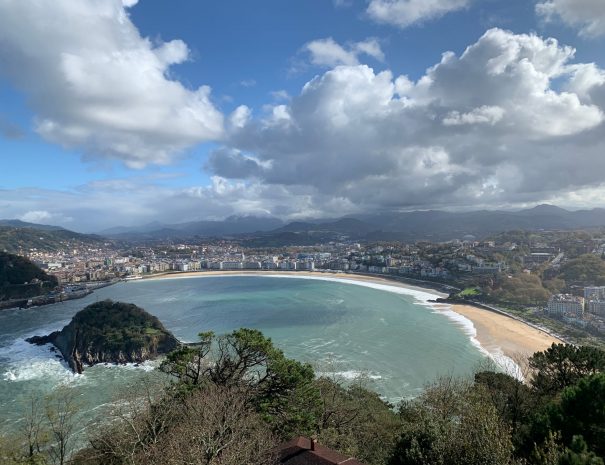
An insiders guide to San Sebastian and the best things to do in 1 day. If you are planning on spending a few days in San Sebastian, Spain, then we suggest reading this post in which we have summed up in an easy guide what there is to see and do and how to get there. … Read More
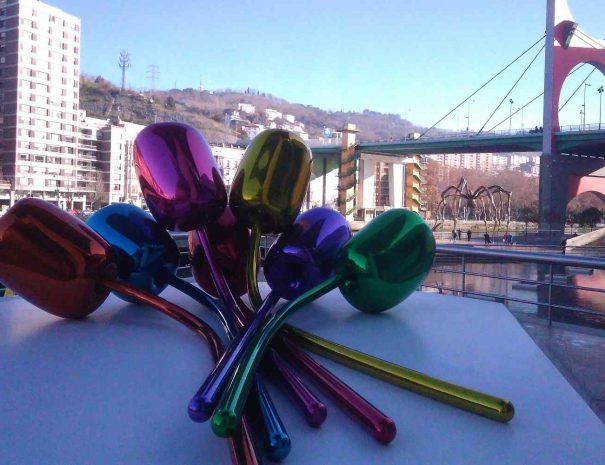
Are you planning a trip to Bilbao in the north of Spain? Are you looking for recommendations for things to do in Bilbao? The city of Bilbao offers one of the best getaways in Basque Country. It is difficult to find a city that has changed so much in such a short amount of time as did Bilbao … Read More

Discover Rioja wine region, a land in Northern Spain famous for its red wines and beautiful landscapes. This is a paradise for food and wine lovers. Peaceful villages, fantastic hotels and one of the best tapas districts in Spain await you … Read More
is proudly powered by WordPress